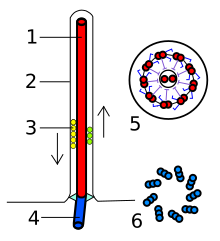
Back جسم قاعدي Arabic Bazno tijelo BS Cos basal Catalan Bazální tělísko Czech Basalkörper German Cuerpo basal Spanish Corpo basal Galician גוף בזאלי HE Corpo basale Italian 基底小体 Japanese


A basal body (synonymous with basal granule, kinetosome, and in older cytological literature with blepharoplast) is a protein structure found at the base of a eukaryotic undulipodium (cilium or flagellum). The basal body was named by Theodor Wilhelm Engelmann in 1880.[1][2] It is formed from a centriole and several additional protein structures, and is, essentially, a modified centriole.[3][4] The basal body serves as a nucleation site for the growth of the axoneme microtubules. Centrioles, from which basal bodies are derived, act as anchoring sites for proteins that in turn anchor microtubules, and are known as the microtubule organizing center (MTOC). These microtubules provide structure and facilitate movement of vesicles and organelles within many eukaryotic cells.
- ^ Engelmann, T. W. (1880). Zur Anatomie und Physiologie der Flimmerzellen. Pflugers Arch. 23, 505–535.
- ^ Bloodgood, R. A. (2009). "From Central to Rudimentary to Primary: The History of an Underappreciated Organelle Whose Time Has Come.The Primary Cilium". Primary Cilia. Methods in Cell Biology. Vol. 94. pp. 3–52. doi:10.1016/S0091-679X(08)94001-2. ISBN 9780123750242. PMID 20362083.
- ^ Schrøder, Jacob M.; Larsen, Jesper; Komarova, Yulia; Akhmanova, Anna; Thorsteinsson, Rikke I.; Grigoriev, Ilya; Manguso, Robert; Christensen, Søren T.; Pedersen, Stine F.; Geimer, Stefan; Pedersen, Lotte B. (2011). "EB1 and EB3 promote cilia biogenesis by several centrosome-related mechanisms". Journal of Cell Science. 124 (15): 2539–2551. doi:10.1242/jcs.085852. PMC 3138699. PMID 21768326.
- ^ Benjamin Lewin (2007). Cells. Jones & Bartlett Learning. p. 359. ISBN 978-0-7637-3905-8. Retrieved 28 July 2019.
© MMXXIII Rich X Search. We shall prevail. All rights reserved. Rich X Search